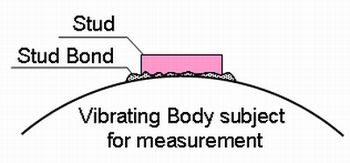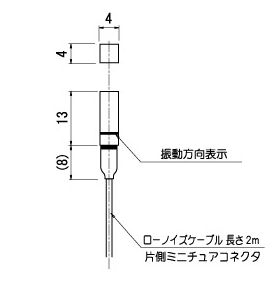PRODUCTS
- Picup
- Preamplifier Type Acceleration Pickup
TYPE 7303
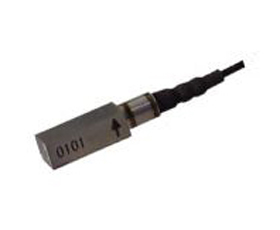
Acceleration pickup is a sensor to detect acceleration or vibration by mounting or contacting onto vibrating body of machinery or equipments.
ACO Co., Ltd. offers wide variety of acceleration pickup, including TYPE 7302 that weighs only 1/5 of 1 Yen coin (0.2g), and other types with temp range of -50℃ to +160℃, meeting various needs required by customers.
With built-in preamplifier type acceleration pickup, expensive charge amplifier is not necessary and extension of the low noise cable is possible, thus reducing the cost for measurement.
In general, acceleration pickup has a main axis with which the acceleration sensitivity becomes its maximum. It is called "Sensing Axis" and align this axis with the desired measurement direction. Normally the sensing axis is close to perpendicular to the mounting base surface of the pickup.
With the pickup fixed to the vibration table and if it is vibrated in the direction of sensing axis, the pickup will provide rating output. Next, if the pickup is mounted on the vibration table with inclination angle θ for the sensing axis and vibrated, the output (SVθ) will be rating output multiplied by cosθ, Output for the sensing axis will be SVθ*cosθ. If the θ is brought to 90 degrees, the output is supposed to become zero however, because of the existence of the Transverse Sensitivity (i.e. Sensitivity in any given direction perpendicular to the sensing axis), there will be some output. In the case of pickups offered by ACO, the lateral axis sensitivity is less than 5%.
Triple axis pickup is very useful since it can measure the vibration in 3 axis simultaneously. It is a convenient sensor to obtain composition of acceleration in 3 axes, or to measure and evaluate human body exposure to the vibration of machinery.
New product, 3 axis 10 mm X 10 mm, was developed in reply to the need to use the pickup at measurement site where only small mounting space is available. It contains preamplifier yet it is small and easy to connect.
Piezoelectric type acceleration pickup is a sensor that utilizes piezoelectric effect, charge generating phenomenon for the distortion due to mechanical stress applied to the piezoelectric element.
It has following features and used in wide range of vibration measurement fields.
【Feature】
・Has high mechanical strength, wide dynamic range and frequency range.
・No static sensitivity because of charge response type.
・External power source is not necessary due to utilization of piezoelectric effect.
・Excellent temporal characteristics due to no damping mechanism.
・Small size and light weight. Easy to mount.

Acceleration applied to the base that is fixed to the specimen (vibrating object) and the weight will produce a force to the piezoelectric element. As a result, the piezoelectric element will generate charge in proportion to the acceleration, thus enabling to measure the acceleration applied to the pickup.
There are 2 types of acceleration pickup depending on the difference how the force is applied to the piezoelectric element. One is compression type and another is shear type. Compression type has a construction in which the piezoelectric element is placed between the base and the weight. It has larger mechanical strength and suitable for measurement of fluctuating vibration that accompanies impact shock.
Shear type has a construction in which shearing force is applied to the piezoelectric element. It is less susceptible for the temperature change.
【Charge Output Type and Built-in Preamplifier Type】
When certain force is applied to the piezoelectric element, charge will be generated. The value expressed with the amount of the charge is called Charge Sensitivity (Unit: pC/(m/s²)). Piezoelectric type pickup can be easily affected by the noise therefore low noise cable is used.
Also when vibration measurement is made by the charge output type pickup, charge amplifier is used to convert the charge to voltage.
Acceleration pickup with Built-in Preamplifier consists of charge output type pickup and preamplifier (impedance converter). It can measure the voltage that is proportional to the input acceleration. It can measure the voltage that is proportional to the input acceleration.
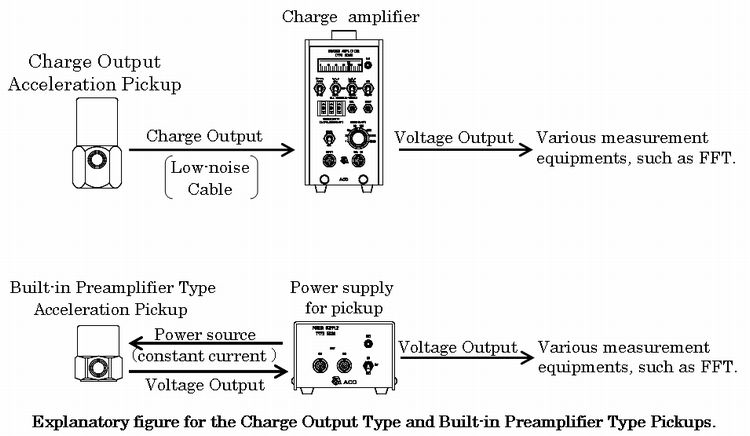
【About constant current circuit】

Acceleration Pickup with Built-in Preamplifier can directly measure the voltage output that is proportional to the input acceleration (unit: mV/(m/s²)). By using the constant current type power supply to the preamplifier, single line can commonly used for the signal transfer (change in voltage) line and power supply (constant current). Low cost coaxial cable (single signal line) can be used and it eliminates the necessity for expensive multi-core cable.
To maintain constant current at all times, constant current diode (CRD: Current Regulative Diode) is used. As shown in the figure, CRD can flow constant current without being affected by the change in voltage.
It is also possible to obtain stable signal by getting the signal (AC component only) through "R" and "C", then connecting it to high impedance devices such as FFT analyzer or digital multi-meter through "R".
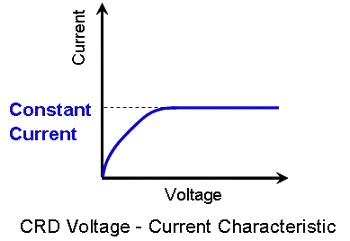
Example of measurement using Acceleration Pickup
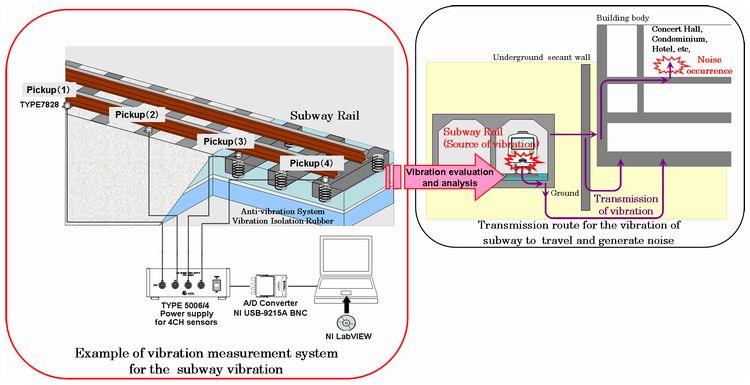
Usually, construction of concert hall, condominium or hotel requires deep piling for their base and such buildings are required to have certain level of "quietness". If there is subway running nearby, it may become a source of noise for such buildings due to the transmission of the vibration trough underground solid objects and cause trouble. To evaluate and analyze such underground vibration, there are cases where vibration from the subway is measured.
Vibration measurement for the Bullet Train or road traffic that are related to Vibration Regulation Act is to measure and evaluate the "vibration level". However, in the case such as the evaluation of noise/vibration from the subway caused by transmission through the solid objects, frequency analysis is required.
When the wheel goes on the rail, it causes vibration through the railroad tie or ballast and it is transmitted to areas along the railway. In this case, rail joints can be a source of large vibration and its level varies by the speed of the train or the number of the cars. To measure and evaluate the condition of transmission of the vibration, simultaneous measurement at multiple points is extremely useful. It is also very effective for other evaluation such as vibration isolation system.
Charge Converter is a small size charge amplifier that converts charge signal into voltage signal.
Charge output type acceleration pickup requires charge amplifier, which however enables direct connection to BNC terminal (constant current compatible) of FFT Analyzer, etc.
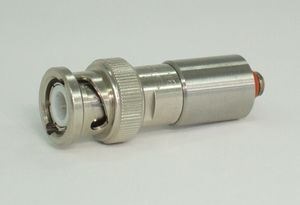
| Gain | 10mV/pc±2.5% (9.75~10.25) Input signal source electrostatic capacitance 1000~2000pF For power source current 2mA at.160 Hz 10mV/pc±5.0% (9.50~10.50) Input signal source electrostatic capacitance 1000~5000pF For power source current 2mA at.160Hz |
|---|---|
| Output Impedance | 500Ω minimum |
| Frequency Range | 2~50kHz (±3dB less than) |
| Maximum Output Voltage | 10Vp-p |
| DC Output Voltage | 10V±2.0 |
| Equivalent input noise level | Less than 0.05pCrms, for input signal source electrostatic capacitance 3500pF and for drive source current 2mA at.2~50kHz |
| Input/Output phase difference | 180° |
| Operating Temperature | 0~+50℃ |
| Operating Humidity | 85%RH (without condensation) |
| Storage Temperature | -20~+80℃ |
| Input Signal Source Insulation Resistance | 5000MΩ minimum |
| Input Signal Source Electrostatic Capacitance | 5000pF minimum |
| Main Body weight | Approx.20g |
| Power Source | DC18~36V、2.0~20mA constant current |
| Input Connector | Miniature Connector (Screw 10-32UNF) |
| Output Connector | BNC Plug |
| Main Body Construction | Not insulated |
| Outline size | φ15×40(L) mm |
| External Case Material | Stainless Steel(SUS303) |
Example of Measurement System
With the Acceleration Pickup with Built-in Preamplifier, measurement and frequency analysis can be easily performed by connecting the pickup to the Sound Card (TYPE 8833A) through Miniature Connecting Cable and Miniature BNC Connector and by using the FFT Analyzer Software (SpectraPLUS).
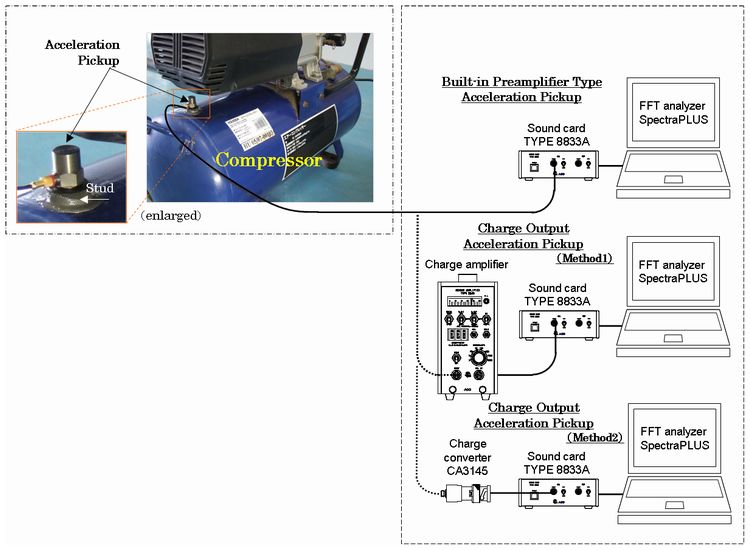
The Most important for mounting the Acceleration Pickup is to firmly contact the mounting surface of the base with the surface of the vibrating body. For that purpose, the surface of the base is finished with high flatness. It is ideal to polish flatly the surface of the vibrating body, apply grease, etc. to the contacting surface and fix tightly with the fixing screw using wrench.
By using ACO's stud (Mounting Base), it is not necessary to machine or finish the mounting surface of the vibrating body. With it, flat surface that is fixed by the screw can be easily obtained and highly reliable vibration measurement becomes available.
Mount Base for 3 axis Pickup is a disposable and very convenient one designed exclusively for the small size 3 axis pickup, which enables easy and accurate mounting of the pickup.
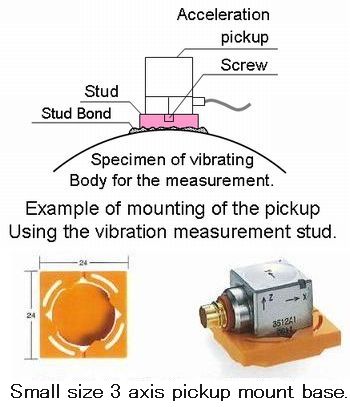
Normally the piezoelectric type acceleration pickup is used under very harsh measurement environment, therefore calibration after long period of usage is required. Such calibration is dependent upon the manufacturer of the pickup, causing high cost for the calibration. MC-20 was developed to solve such problem. It contains vibrator, amplifier and display in a single body and calibration can be carried out quickly by simply connecting the sensor with substantially lower cost.
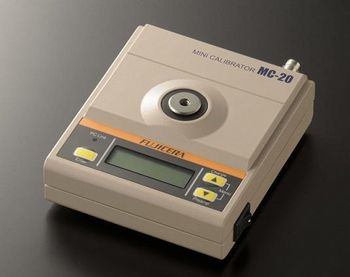
Example of Use
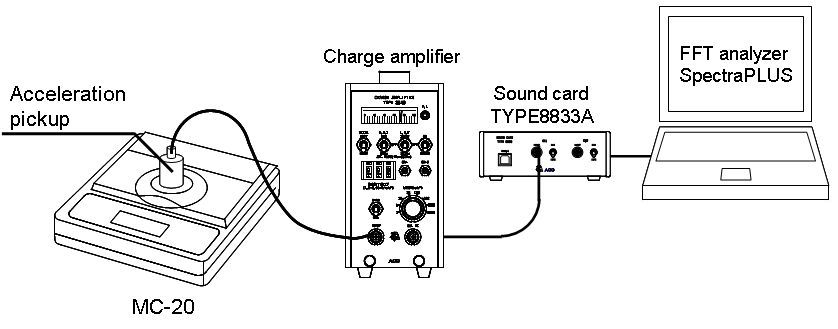
Pickup Cable is a cable prepared exclusively for the Acceleration Pickup, taking durability and easy routing into consideration to cope with various needs at measurement site.
Wide variety of types with different length, different maximum temperature, or for 3 axis simultaneous measurement, etc. are available.
| Type | Length | Appearance diagram * Click the figure to see enlarged drawing. | Maximum Temperature |
|---|---|---|---|
| BC-0062 | 1.5m |  | 250℃ (Low Noise Cable) |
| 3m | |||
| 5m | |||
| 10m | |||
| BC-0064 | 1.5m |  | 105℃ (Coaxial Cable) |
| 3m | |||
| 5m | |||
| 10m | |||
| BC-0065 | 1.5m |  | 160℃ (Low Noise Cable) |
| 3m | |||
| 5m | |||
| 10m | |||
| BC-0061 | 3m |  | 105℃ (Coaxial Cable) |
Screw, Attachment, etc.
For realize highly reliable measurements, various items such as exclusively designed screws, contact pin that is convenient for pin-point measurement, or mounting base for the vibration measurement (stud), etc. are available.
Junction Connector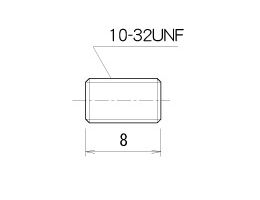 | Magnet Attachment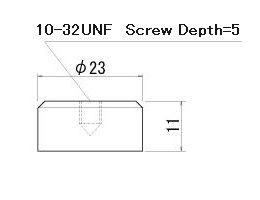 |
Contact Pin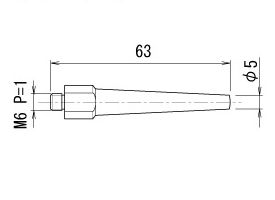 | M6 UNF Flange Screw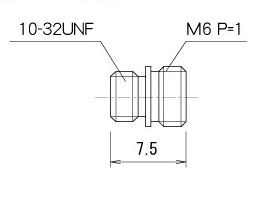 |
Charge Converter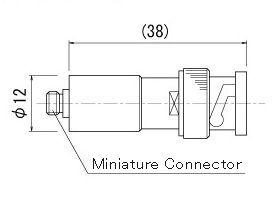 | Miniature BNC Adapter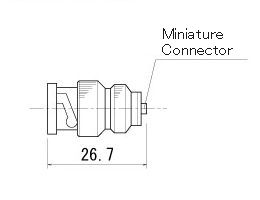 |
Insulation Attachment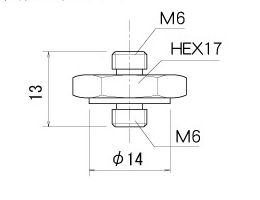 | M3 Screw |
10-32 UNF Screw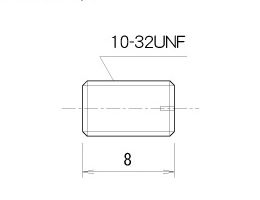 | Toyo Stud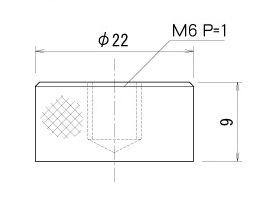 |
* Click the figure to see enlarged drawing.
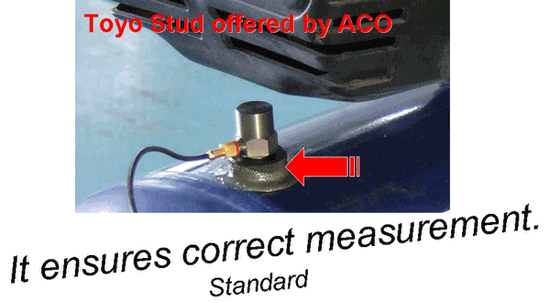
Control and maintenance of facilities and equipments start from correct vibration measurement.
With Toyo Stud, mount base (stud) for the acceleration pickup is bonded to the point subject for the measurement to obtain highly reliable data, without any necessity of machining. In the past, changes in measurement conditions and individual differences caused variation in the result each time the measurement was made, and any person in charge of controlling the facility and equipment has been bothered by it. ACO noted that the surface condition of the vibrating body subject for the measurement is sometimes round, uneven, contaminated, or painted, all preventing ideally tight contact between the surface and the acceleration pickup, which led to the development of Toyo Stud. Toyo Stud can solve such problem on surface conditions only by bonding it to the surface subject for the measurement. With it the measurement point can be fixed and enables vibration measurement with high reliability and repeatability.
(1)Eliminate the necessity of machining such as boring to the facility or equipment.
(2)Easy to bond.
(3)High mechanical strength after bonding.
(4)Have wide frequency range.
(5)Can be permanently used.
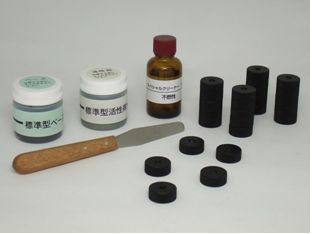
【Frequency response of Toyo Stud】
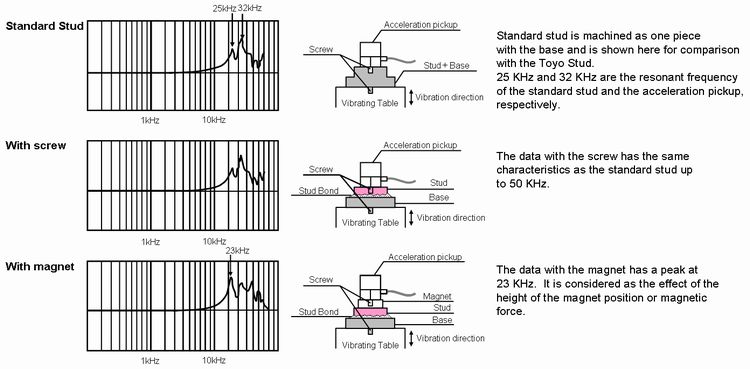
Reference Data

| Material / Plating | Type No. | Mounting type | Outline size | Appearance |
|---|---|---|---|---|
| Iron (Chrome plating - black) | SS22 | Flat Surface | 22φ×8 | 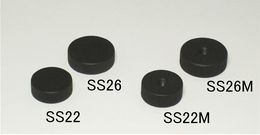 |
| SS26 | ||||
| SS22M | Threaded Hole | |||
| SS26M | ||||
| Stainless steel | SU22M |  |
||
| SU26M | ||||
| Please consult with ACO if there is any other special requirement for the stud configurations. | ||||

【Mounting Method】
